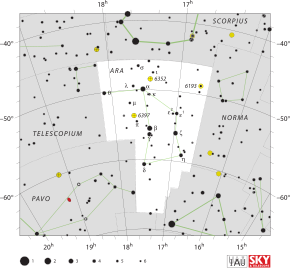
Back Altaar (sterrebeeld) Afrikaans المجمرة (كوكبة) Arabic ارا (كوكبه) ARZ Qurbangah (bürc) Azerbaijani Ҡорбан салыу урыны (йондоҙлоҡ) Bashkir Ахвярнік (сузор’е) Byelorussian Ахвярнік (сузор’е) BE-X-OLD Жертвеник (съзвездие) Bulgarian Aoter (steredeg) Breton Oltar (sazviježđe) BS
| Constellation | |
 | |
| Abbreviation | Ara[1] |
|---|---|
| Genitive | Arae[1] |
| Pronunciation | /ˈɛərə/, genitive /ˈɛəriː/[a] |
| Symbolism | the Altar[1] |
| Right ascension | 16h 34m 16.9497s–18h 10m 41.3407s[2] |
| Declination | −45.4859734°–−67.6905823°[2] |
| Area | 237 sq. deg. (63rd) |
| Main stars | 8[1] |
| Bayer/Flamsteed stars | 17 |
| Stars with planets | 7 |
| Stars brighter than 3.00m | 2 |
| Stars within 10.00 pc (32.62 ly) | 3 |
| Brightest star | β Ara (2.84m) |
| Messier objects | 0 |
| Meteor showers | 0 |
| Bordering constellations | |
| Visible at latitudes between +25° and −90°. Best visible at 21:00 (9 p.m.) during the month of July. | |
Ara (Latin for "the Altar") is a southern constellation between Scorpius, Telescopium, Triangulum Australe, and Norma. It was (as Βωμός, Bōmǒs) one of the Greek bulk (namely 48) described by the 2nd-century astronomer Ptolemy, and it remains one of the 88 modern constellations designated by the International Astronomical Union.
The orange supergiant Beta Arae, to us its brightest star measured with near-constant apparent magnitude of 2.85, is marginally brighter than blue-white Alpha Arae. Seven star systems are known to host planets. Sunlike Mu Arae hosts four known planets. Gliese 676 is a (gravity-paired) binary red dwarf system with four known planets.
The Milky Way crosses the northwestern part of Ara. Within the constellation is Westerlund 1, a super star cluster that contains the red supergiant Westerlund 1-26, one of the largest stars known.
- ^ a b c d Ridpath & Tirion 2001, pp. 82–83.
- ^ a b "Ara, constellation boundary". The Constellations. Retrieved 14 February 2014.
Cite error: There are <ref group=lower-alpha> tags or {{efn}} templates on this page, but the references will not show without a {{reflist|group=lower-alpha}} template or {{notelist}} template (see the help page).